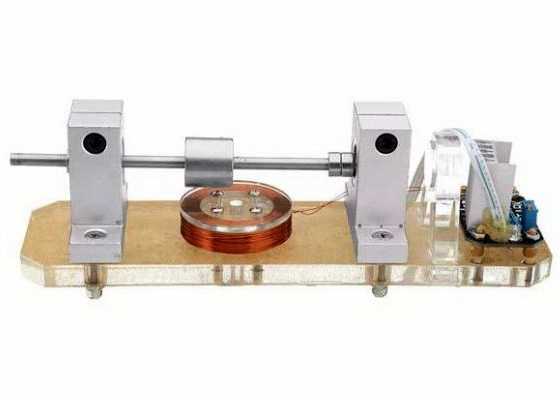2015-02-27
【Aiden in English】
Motors are all around us. There are in cars, fans, blenders, and many other things. They make our lives simpler, but barely anyone wonders what motors are made of and how they work. We just ignore a crucial invention that helps us. In science class for the past few weeks, we have been studying and building different kinds of motors, such as the straw compass motor, the spinning coil motor, and the armature motor. All of these motors are used in our everyday lives, and this was the first time that I really looked into the simple machine that powered many things.
The straw compass is one of the simpler motors that our science class did. It used electricity, to make an electromagnet, or a magnet that runs on electricity. The electricity flowed through a circuit, or an unbroken path of an electric current, and flowed through a coil. The coil became magnetic, and it would attract or repel, or push and pull, any magnet that came close. Then, we stuck a magnet on both ends of a straw, balanced the straw on a cup, and moved the coil closer to the magnets. When we turned on the electricity by completing the circuit with a switch, the magnets spun. After a while, the straw slowed down to a stop with a magnet pointing towards the coil. Whichever face of the magnet pointed towards the coil, the coil had to be the opposite polarity, of north or south. With magnets, opposites attract, and similarities repel, and so north and south attract, and north and north and south and south repels. With the straw compass motor, to keep the straw spinning, timing the switch was crucial because we have to time when the correct polarity comes around. This motor was the hardest of the three, and many of us failed to make it work.
The second motor that we learned about was much easier, but if it didn’t work the first time, troubleshooting, or fixing, was hard. It was called the spinning coil motor, and sometimes, it was a pain in the butt. It had a cup to hold up the motor, and on top of the cup were two bare, brass wire arms. These arms were strapped to the cup by two rubber bands on opposite sides of the cup, and on the ends of the wires was an alligator clip with a wire twisted around it. Those wires were connected to a battery and a switch, making the circuit. The bare, brass wires were twisted in a loop on top of the cup, making an arm. Then, we took a red wire, wrapped it into a loop, and sandpapered the ends to take off the red insulator on the surface. By doing this, the electricity could flow through the wire. Place the loop between the arms and a magnet under the loop, and the loop would spin as soon as the switch was turned on. The coil spun because of the automatic switch, or the brass arms. The electricity went around the coil in circles, which made the coil spin.
The armature really got the class’s attention. It used a part of a real motor in the center called the armature, hence the name. The armature has magnets attached to its sides, making it stick to some metals. There was a shaft sticking out one end, and on the other was a brass part called the commutator. We used the same setup as the spinning coil motor, but only with one brass arm. The other was a red and white wire taped together with electric tape and strapped to the opposite side of the brass arm. The exposed parts of the red and white wires were bent into the shape of a V. We placed the commutator on the V and placed the shaft on the brass arm. We turned on the switch, and when we moved a magnet near the armature, it spun with amazing speed. A whirring sound would fill the air, and we could make it spin faster or slower by either moving the magnets farther away or closer. Also, if we flipped the red and white wires, flipped the battery, or turned over the magnets, the direction of the spinning armature would change, forward or backward.
Motors are used in our everyday lives, yet as much as they are everywhere, we’ve grown so used to them that they just seem to become a part of our world. Our science curriculum on motors has really shown me what the machinery was in simple things and described how they work. With motors, the world seems as big as ever.
【紅霞譯文】
發電機應用廣泛,汽車、風扇、攪拌機以及其它五花八門的機器都有馬達裝置。發電機雖讓我們的生活變得更加便利,但極少有人對其製作和運轉發生興趣,因而忽略了一些至關重要的科技發明。過去幾周的科學課上,同學們一直忙於學習組裝幾種不同形式的發電機,比如:吸管羅盤發電機、旋轉線圈發電機、電樞發電機,日常生活離不開些發電機,我也是第一次接觸這類結構簡單而功能卻又複雜的玩藝。
吸管羅盤發電機屬於科學課上介紹的較為便捷的馬達之一,有電的地方就有電磁場,即帶電的磁場,電流通過電路板或者完好無缺的線圈使電線變成電場,當任何兩個電場相遇,彼此不是相吸就是相斥,即所謂的推拉作用。我們在吸管兩端各綁上磁鐵,並吸管中央墊上一隻杯子,這時再把線圈移近磁鐵。等打開開關通電之後,磁鐵靠磁力轉起圈來;不一會兒,吸管漸停,磁鐵指向線圈,無論磁鐵哪一側面對線圈,必定正負極相反,要麼沖北要麼朝南。就磁鐵本身而言,異性相吸同性相斥,所以南北相吸,北對北或南對南相斥。欲要保持吸管不停地旋轉,定時開關至關重要,只有這樣才能確保整個羅盤的方向,正因如此,吸管羅盤發電機是三種發電機中最難掌控的,許多同學最終也未能操作成功。
我們學的第二個旋轉線圈發電機相對比較容易,但頭一回上手難度還是挺大,需要排除故障找出解決辦法,有時真叫人着急上火。具體做法是,用一個杯子撐住馬達,杯子頂端拴上兩根赤裸裸的銅絲棒,銅絲棒的一端靠兩條橡皮筋被固定在杯子兩側,另一端各有電線環繞的彈簧夾,彈簧夾連通電池及開關形成閉式電路。隨後,我們把紅色電線彎成環狀正掛杯上,兩頭用砂紙打磨以去掉外部紅色絕緣材料,這樣電流通過電路就會暢通無阻。將銅絲棒之間接上金屬線圈,線圈下放置磁鐵,一旦打開開關,線圈立刻開始轉動。線圈之所以旋轉是因為自動開關即銅絲棒導電,電流通過線圈帶動線圈旋轉起來。
電樞可謂全班同學最為感興趣的話題,其實它不過是整個電機的組成部分,電樞馬達由此而得名。電樞的側面極富磁性,只要碰到金屬物質便自動粘在一起。電樞有一中軸,一端伸出體外,另一端帶銅芯的部分叫換向器。大家按照旋轉線圈發電機的操作方法將線路連接好,不過在這裡只需要一根銅線就夠了,紅白電線先用隔緣膠帶綁在一起固定到銅線末端,再將紅白電線彎成V字形,然後把換向器放在V字形上。這時,我們打開開關,隨着磁鐵移近電樞,電樞飛快轉動起來,由此發出驚天動地的鳴叫聲。通過調整磁鐵與電樞的距離,電樞的轉速時快時慢;如果對換紅白電線的位置,或者將電池倒一下方向,或者給磁鐵翻個身,電樞的轉向要麼向前要麼向後。
日常生活離不開發電機,發電機隨處可見,並且早已滲透到各個角落。科學課發電機專題確實教我了解常見的機械化裝置及其工作原理,由於發電機的存在,世界似乎變得越來越大。







